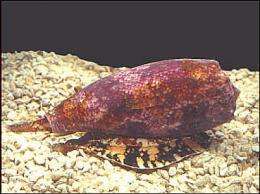May 20, 2011 report
Researcher shows how cone snails developed poison gland from spare gut parts

(PhysOrg.com) -- Canadian Louise Page, associate professor at the University of Victoria, BC, has solved a mystery that has perplexed zoologists since early 19th century naturalists first wondered if venomous cone snails might have developed their poison producing glands through evolution of their esophagus somehow; speculation that of course led many to wonder if that were so, how did the snail continue with swallowing and digesting its food.
Cones as they are known colloquially, are a genus of snails that use a small tube to shoot harpoon-like teeth connected to a radula (a spaghetti like string) through a proboscis at suspecting prey to stun or kill it; they then haul their prey back to them and devour it, spitting out the parts they don’t like. The snail can turn and point the proboscis (which looks sort of like a cartoon version of a tiny elephant’s trunk) at its prey and after loading a tooth with poison launch it’s "harpoon" by forcefully contracting muscles, situated at the base of the proboscis. Some estimates put the number of different species of cone snails in the neighborhood of six hundred or so, of varying sizes and coloring; though most are pretty little, some can grow to as long as 23 centimeters (about nine inches) and pack sufficient punch to kill a human being.
Page found the answer in Hawaii, home of the cone snail species Conus lividus, where, as she describes in her paper in Proceedings of the Royal Society B, she grabbed a mass of eggs, took them back to her lab and set about hatching and raising them. Along the way she singled out specimens during different stages of their development (when they were still larvae) fixed them with chemicals and sliced them up and photographed them to see what was going on. She then fed the whole batch of photos into a computer program that allowed her to watch as the larvae developed, and was then able to see that the cone snail originally has two sets of digestive tracts, one of which develops into the venom gland. Mystery solved.
Page explains that the process is known as modular evolution, whereby a species develops a trait over time without disrupting other important bodily functions, something that has been seen in a wide range of other animals and insects.
More information: Developmental modularity and phenotypic novelty within a biphasic life cycle: morphogenesis of a cone snail venom gland, Proc. R. Soc. B, Published online before print May 18, 2011, doi: 10.1098/rspb.2011.0501
Abstract
The venom gland of predatory cone snails (Conus spp.), which secretes neurotoxic peptides that rapidly immobilize prey, is a proposed key innovation for facilitating the extraordinary feeding behaviour of these gastropod molluscs. Nevertheless, the unusual morphology of this gland has generated controversy about its evolutionary origin and possible homologues in other gastropods. I cultured feeding larvae of Conus lividus and cut serial histological sections through the developing foregut during larval and metamorphic stages to examine the development of the venom gland. Results support the hypothesis of homology between the venom gland and the mid-oesophageal gland of other gastropods. They also suggest that the mid-region of the gastropod foregut, like the anterior region, is divisible into dorsal and ventral developmental modules that have different morphological, functional and ontogenetic fates. In larvae of C. lividus, the ventral module of the middle foregut transformed into the anatomically novel venom gland of the post-metamorphic stage by rapidly pinching-off from the main dorsal channel of the mid-oesophagus, an epithelial remodelling process that may be similar to other cases where epithelial tubes and vesicles arise from a pre-existing epithelial sheet. The developmental remodelling mechanism could have facilitated an abrupt evolutionary transition to the derived morphology of this important gastropod feeding innovation.
© 2010 PhysOrg.com
















